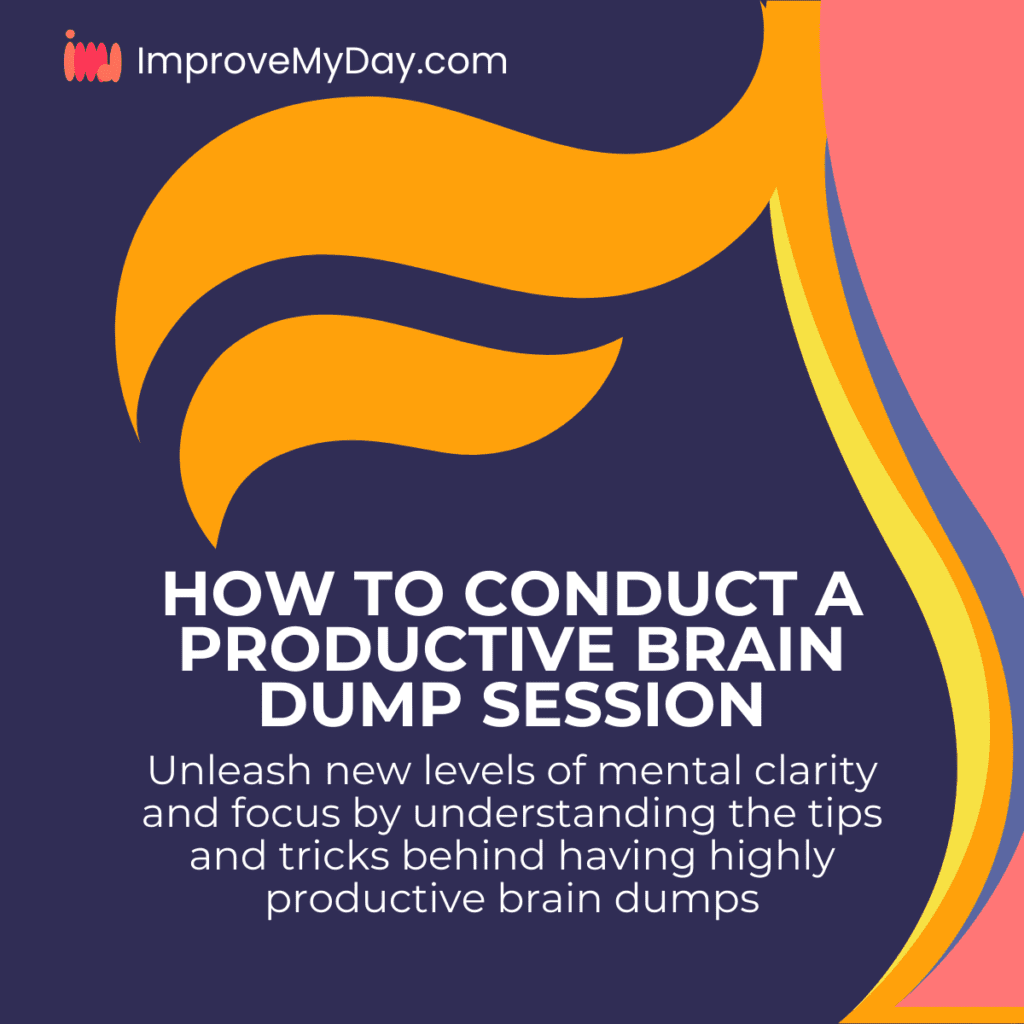A brain dump session is a dedicated time where you transfer all the thoughts, ideas, tasks, and information from your mind onto paper or a digital medium. It’s a form of mental decluttering that allows you to capture everything floating around in your head without judgment or organization.
According to productivity expert David Allen, author of “Getting Things Done,” our brains are great at generating ideas but poor at storing them. By regularly engaging in brain dump sessions, you can free up mental space and improve your cognitive function.
- The Benefits of Regular Brain Dumps
- Preparing for Your Brain Dump Session
- Steps to Conduct a Productive Brain Dump Session
- Organizing and Processing Your Brain Dump
- Incorporating Brain Dumps into Your Routine
- Overcoming Common Challenges
- Advanced Techniques for Brain Dump Sessions
- Conclusion: Your Path to Mental Clarity
The Benefits of Regular Brain Dumps
Before we dive into the how-to, let’s explore why brain dump sessions are so valuable:
- Reduced mental clutter: By externalizing your thoughts, you clear space in your mind for more important tasks.
- Decreased stress and anxiety: Getting things out of your head can alleviate the pressure of trying to remember everything.
- Improved focus: With fewer distractions in your mind, you can concentrate better on the task at hand.
- Enhanced creativity: Brain dumps can uncover connections between ideas you hadn’t noticed before.
- Better task management: By capturing all your tasks, you can prioritize and plan more effectively.
Preparing for Your Brain Dump Session
To make the most of your productivity brain dump session, proper preparation is key. Here’s how to set yourself up for success:
Choose the Right Time and Place
Select a time when you’re alert and free from distractions. Many people find early mornings or late evenings work well. Find a quiet, comfortable space where you won’t be interrupted.
Gather Your Tools
Decide whether you prefer analog or digital methods. Some options include:
- Notebook and pen
- Blank sheets of paper
- Digital note-taking app (e.g., Evernote, OneNote)
- Voice recording app
- Mind mapping software
Choose the method that feels most natural and effortless for you.
Steps to Conduct a Productive Brain Dump Session
Now that you’re prepared, let’s walk through the process of conducting an effective brain dump:
1. Set a Clear Intention
Begin by taking a few deep breaths and setting an intention for your session. This could be to clear your mind, generate ideas for a project, or organize your tasks for the week ahead.
2. Start with Timed Free-Writing
Set a timer for 10-15 minutes and start writing or typing everything that comes to mind. Don’t worry about organization or coherence at this stage. The goal is to get everything out of your head and onto your chosen medium.
3. Use Prompts or Categories
If you find yourself stuck, use prompts or categories to stimulate your thought process. Some examples include:
- Work tasks
- Personal errands
- Creative ideas
- Concerns or worries
- Goals and aspirations
- Household chores
4. Capture Everything Without Judgment
As thoughts arise, jot them down without evaluating their importance or feasibility. This is not the time for filtering or decision-making. Embrace the stream of consciousness and let your thoughts flow freely.
5. Keep Going Until You Feel Complete
Continue your brain dump until you feel a sense of mental relief or clarity. This might take 15 minutes or an hour, depending on how much is on your mind.
Organizing and Processing Your Brain Dump
Once you’ve completed the initial dump, it’s time to make sense of what you’ve captured:
1. Review and Categorize
Read through everything you’ve written and start grouping similar items together. Common categories might include:
- Urgent tasks
- Long-term projects
- Ideas to explore
- Personal development goals
- Errands or chores
2. Prioritize
Identify the most important or time-sensitive items. You might use a system like the Eisenhower Matrix to categorize tasks based on urgency and importance.
3. Create Action Plans
For each major category or project, create a basic action plan. Break down larger tasks into smaller, manageable steps.
4. Transfer to Your Task Management System
Move actionable items to your preferred task management tool, whether it’s a to-do list app, a planner, or a project management platform.
Incorporating Brain Dumps into Your Routine
To reap the full benefits of this productivity technique, consider making brain dump sessions a regular part of your routine:
Frequency
Experiment with different frequencies to find what works best for you. Some options include:
- Daily quick dumps (5-10 minutes)
- Weekly comprehensive sessions (30-60 minutes)
- Monthly big-picture reviews
Integration with Other Productivity Systems
Brain dumps can complement other productivity methods, such as:
- The Getting Things Done (GTD) methodology
- Bullet journaling
- Time blocking
- The Pomodoro Technique
Use brain dumps as a way to feed into these systems, ensuring you’re capturing all potential tasks and ideas.
Overcoming Common Challenges
Even with practice, you may encounter some hurdles in your brain dump sessions. Here’s how to address them:
Writer’s Block
If you’re struggling to get started:
- Begin with simple lists (e.g., today’s tasks, things you’re grateful for)
- Use random word prompts to spark ideas
- Start by describing your current environment or emotional state
Dealing with Overwhelm
If the sheer volume of thoughts is overwhelming:
- Break your session into smaller chunks with short breaks in between
- Focus on one category at a time
- Remind yourself that capturing thoughts doesn’t mean you have to act on all of them immediately
Maintaining Consistency
To build a brain dump habit:
- Schedule sessions in your calendar
- Pair brain dumps with an existing habit (e.g., morning coffee)
- Keep your tools easily accessible
- Celebrate the mental clarity you achieve after each session
Advanced Techniques for Brain Dump Sessions
As you become more comfortable with basic brain dumps, you might want to explore advanced techniques:
Digital vs. Analog Methods
Experiment with both to see which yields better results for you. Digital methods offer searchability and easy reorganization, while analog methods can provide a more visceral, distraction-free experience.
Mind Mapping
Use mind maps to visually connect ideas and see relationships between different thoughts. This can be particularly useful for creative projects or complex problem-solving.
Voice Recording
For those who prefer verbal processing, try recording your thoughts and then transcribing or summarizing the key points afterward.
Conclusion: Your Path to Mental Clarity
Conducting regular, productive brain dump sessions is a powerful way to achieve mental clarity, reduce stress, and boost your overall productivity. By following the steps outlined in this guide and making brain dumps a consistent part of your routine, you’ll be well on your way to a more organized mind and a more effective approach to managing your thoughts and tasks.
Remember, the key to a successful brain dump is to make it a judgment-free zone where all thoughts are welcome. With practice, you’ll find that this simple yet powerful technique can transform your productivity and help you navigate the complexities of modern life with greater ease and focus.
Start small, be consistent, and watch as your mental clutter transforms into clear, actionable plans.



